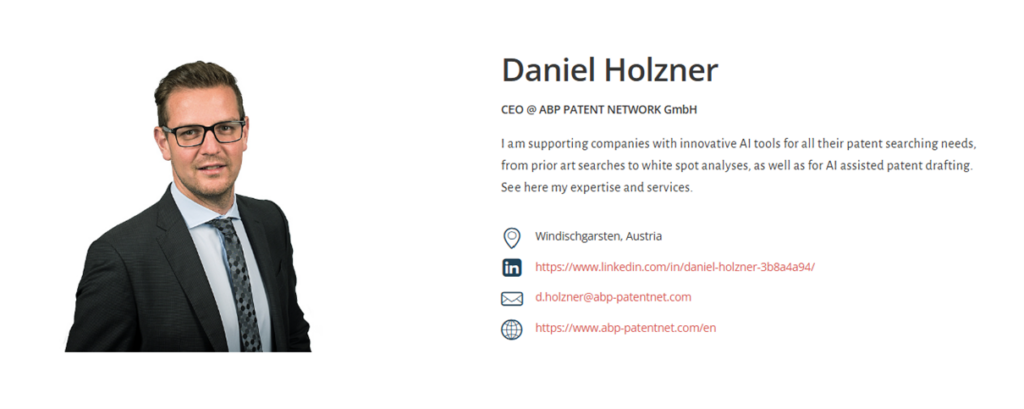Daniel Holzner is Subject Matter Expert in the CEIPI-EPO Master of IP Law and Management
Technological innovation👉 Practical application of new ideas to create value. is the lifeblood of modern industry, driving competitiveness, market relevance, and long-term growth. However, managing innovation is far from straightforward. Companies face a labyrinth of challenges, from rapidly evolving technologies to the complexities of IP protection. This post is a summary of the third module of the CEIPI-EPO Master’s Program in IP Law and Management (MIPLM) on the topic of Managing Technological Innovation. An overview of this lecture is available here:
In this blog post, we explore the hurdles in technological innovation management, the specific IP-related obstacles that arise, and how AI-supported strategies—exemplified by Daniel Holzner’s methodologies with uptoip patentbutler technology—offer transformative solutions. Daniel Holzner is a Subject Matter Expert for AI-supported innovation and invention👉 A novel method, process or product that is original and useful. processes at the CEIPI-EPO MIPLM.
Challenges in Technological Innovation Management
The pace of technological change has accelerated dramatically, reshaping industries and forcing companies to adapt or risk👉 The probability of adverse outcomes due to uncertainty in future events. obsolescence. Managing innovation requires navigating a complex interplay of incremental improvements, radical breakthroughs, and market alignment—all while balancing resource constraints and strategic priorities. In this dynamic environment, organizations must overcome barriers such as technological uncertainty, competitive pressures, and the emergence of dominant designs to sustain growth and relevance.
👉 https://ip-management-voice.podigee.io/7-ai-assisted-invention-processes
👉 https://ipbusinessacademy.org/ai-based-patent-search-for-synthetic-inventing
👉 https://profwurzer.com/ai-supported-innovation-management
Below are key challenges that organizations grapple with:
Rapid Technological Change and Disruption
Industries today are defined by accelerating technological advancements. Innovations such as AI, IoT, and quantum computing redefine markets faster than ever. For instance, the shift from analogue to digital mobile technology in the 1990s caught incumbents like Motorola off guard, while newcomers like Nokia capitalized on the disruption. Companies must continuously adapt to avoid obsolescence but predicting which technologies will dominate is fraught with uncertainty. The “S-curve” model illustrates how technologies improve incrementally until a disruptive innovation👉 Innovation that transform markets by being more accessible than established ones. resets the cycle, leaving firms that fail to pivot stranded.
- Managing Diverse Innovation Types
Not all innovations are equal. Incremental innovations (e.g., refining smartphone designs) require different strategies than radical innovations (e.g., transitioning from fossil fuels to renewable energy). Modular innovations (upgrading individual components) and architectural innovations (redesigning entire systems) add further complexity. For example, Dell’s process innovation in supply chain management revolutionized PC manufacturing, but sustaining this advantage required balancing cost efficiency with evolving consumer needs. - Resource Allocation and R&D Risks
Innovation demands significant investment in R&D, yet outcomes are uncertain. The case of Iridium’s satellite communication system highlights this: despite groundbreaking technology, initial market misalignment led to bankruptcy before a pivot to niche markets saved the company. Firms must decide whether to be first movers—risking high costs and unproven markets—or followers, who face entrenched competition👉 Rivalry between entities striving for a shared goal or limited resource.. - Aligning Innovation with Market Needs
Customer requirements often evolve faster than R&D cycles. The failure of early PDAs, like Apple’s Newton, stemmed from misjudging user needs and overestimating the maturity of enabling technologies (e.g., battery life, handwriting recognition). Companies must bridge the gap between cutting-edge R&D and practical, market-ready solutions. - Navigating Dominant Designs and Standardization
Dominant designs, like the QWERTY keyboard or VHS format, emerge when a product configuration becomes industry-standard. While standardization reduces costs, it also stifles differentiation. Firms must decide whether to compete within established frameworks or pioneer new standards—a high-risk, high-reward proposition.
Introduction to the management of innovation:
IP Management Challenges in Innovation
Intellectual property👉 Creations of the mind protected by legal rights. is a double-edged sword: it protects innovations but introduces strategic complexities.
- Patent👉 A legal right granting exclusive control over an invention for a limited time. Landscapes and Infringement Risks
Navigating dense patent landscapes is a minefield. Competitors’ patents can block market entry, while inadvertent infringement risks costly litigation. For example, the format war between Betamax and VHS was as much about patents as it was about consumer preference. Companies must conduct exhaustive prior-art searches and design around existing claims—a process both time-consuming and uncertain. - Timing and Integration of IP Strategy👉 Approach to manage, protect, and leverage IP assets.
IP protection must align with product development stages. Filing too early risks exposing ideas prematurely; filing too late cedes ground to competitors. The case of Philips’ VCR technology, which was commercialized more effectively by Japanese firms, underscores the importance of synchronizing IP strategy with market readiness. - Maintaining Competitive Advantage
IP portfolios must balance breadth and focus. Overly narrow patents offer limited protection, while overly broad ones invite challenges. Trade secrets, trademarks, and design rights add layers of complexity. For instance, Coca-Cola’s recipe secrecy and brand👉 A distinctive identity that differentiates a product, service, or entity. trademarks are as critical as its patents. - Invention Harvesting and Commoditization
Many firms struggle to systematically identify patentable ideas within R&D processes. Invention harvesting—proactively mining innovations from existing projects—requires cultural and procedural shifts. Without this, commoditization erodes margins, as seen in the smartphone industry, where hardware differentiation has stagnated. - Legal and Strategic Alignment
Global IP regimes vary widely, complicating international expansion. Additionally, open innovation models (e.g., collaborations, toolkits for lead users) blur ownership lines, requiring clear agreements to avoid disputes.
AI-Supported Innovation Management: The Daniel Holzner Approach
Daniel Holzner’s AI-driven framework represents a paradigm shift in how companies address the complexities of innovation and intellectual property management. By integrating artificial intelligence into the innovation process👉 A structured journey of creating and implementing new ideas., Holzner has with the patentbutler developed a methodology that not only mitigates traditional challenges but also unlocks new opportunities for strategic growth. His approach exemplifies best practices in leveraging cutting-edge technology to streamline invention processes, optimize IP portfolios, and align innovation strategies with market demands.
In an era where technological advancements outpace traditional management practices, Daniel Holzner’s AI-supported framework offers a transformative solution to navigating the complexities of innovation and intellectual property. By harnessing AI for tasks such as patent analysis, invention harvesting, and strategic portfolio management👉 Strategic management of diverse assets to optimize returns and balance risk., Holzner has redefined how companies identify opportunities and protect their competitive edge. His methodologies exemplify the integration of data-driven insights into corporate strategy, ensuring that businesses remain agile and forward-thinking in today’s dynamic landscape.
- AI-Powered Patent Analysis and White Spot Identification
Holzner’s methodologies leverage AI to analyse patent databases and scientific literature, identifying “white spots”—underdeveloped technological areas with high potential. For example, AI algorithms can map trends in optical sensor patents, highlighting opportunities for breakthroughs while avoiding saturated fields. This reduces R&D redundancy and focuses resources on high-impact projects. - Systematic Invention Harvesting
Traditional R&D often leaves ideas undocumented or under protected. Holzner’s approach embeds AI tools into the innovation pipeline, automatically flagging patentable concepts during development. This was critical in a case study involving synthetic biology, where AI cross-referenced experimental data with global patents to identify novel enzyme applications. - Enhancing R&D Efficiency
AI accelerates prototyping and testing. Predictive analytics assess the viability of innovations early, minimizing costly dead-ends. In the automotive sector, AI-driven simulations reduced development time for electric vehicle batteries by 40%, while patent analytics ensured designs circumvented competitors’ IP. - Strategic IP Portfolio Management
Holzner’s models dynamically align IP strategy with business goals. For instance, AI evaluates market trends to prioritize patents in emerging fields (e.g., AI ethics) while divesting non-core assets. This proactive approach mirrors 3M’s success in pivoting from adhesives to healthcare technologies through targeted IP investments.
Recording of the live interview on AI-based patent management as part of the 🖥️𝗜𝗣 𝗕𝘂𝘀𝗶𝗻𝗲𝘀𝘀 𝗧𝗮𝗹𝗸𝘀:
MIPLM Case Study: AI Assisted Inventing
How can AI be used to systematically develop patent portfolios, analyze patent literature, perform feature comparisons and support the entire invention process? These were the questions discussed in the final module of the MIPLM (Master for Intellectual Property Law and Management) Master’s program 2024. The associated case study is presented here:
👉 https://ipbusinessacademy.org/ai-assisted-inventing-new-case-study-at-the-miplm
Conclusion: Transforming Challenges into Opportunities
The intersection of technological innovation and IP management👉 Strategic and operative handling of IP to maximize value. is fraught with challenges—from disruptive technologies to patent wars. Yet, these hurdles also present opportunities for differentiation. Daniel Holzner’s AI-supported strategies exemplify how modern tools can de-risk innovation, optimize IP portfolios, and align R&D with market realities. By embracing data-driven decision-making, companies can navigate complexity, secure competitive advantages, and turn visionary ideas into commercial successes. In an era defined by rapid change, such approaches are not just advantageous—they are essential.

